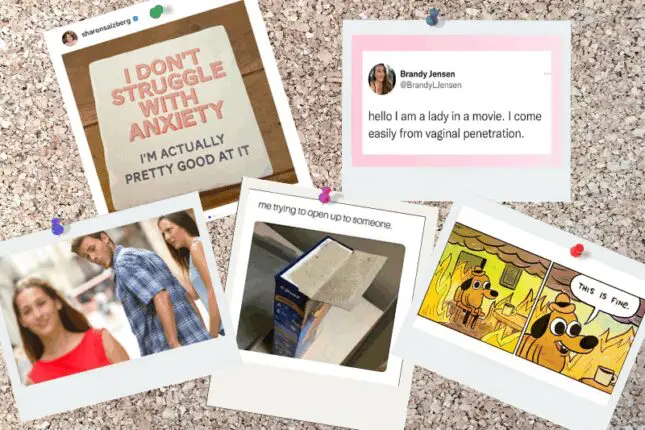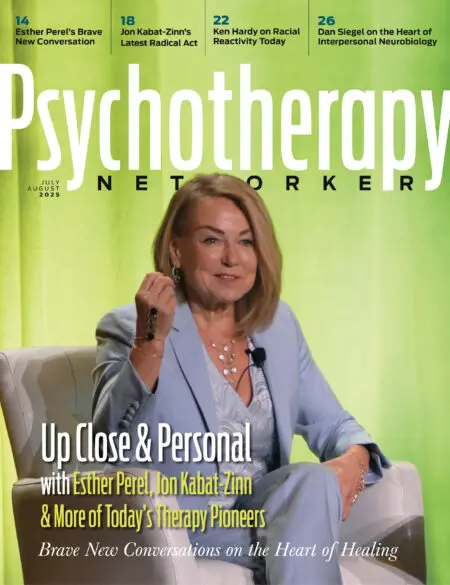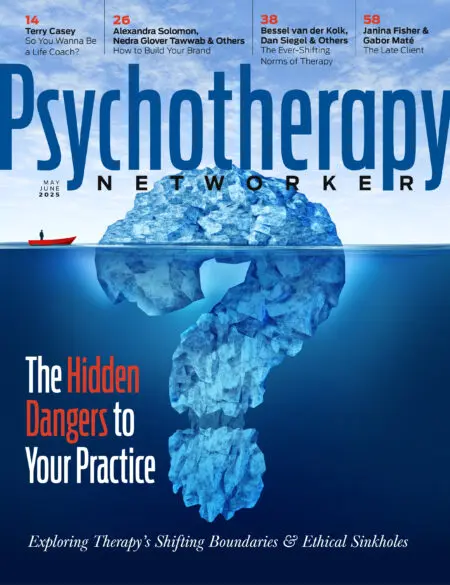Enjoy the audio version of this article—perfect for listening on the go.
Ahh, memes—those wacky, humorous images that float around us like digital candy, easy to digest and even easier to share. But memes are also cultural touchstones, universal portals into our collective grief, pain, and frustrations. They can join us together in laughter, turn concepts we thought we knew on their heads, and speak truth to power—all in a single graphic.
As you’ll read below, plenty of therapists have favorite memes, ones they share often with colleagues and even clients. It’s a bold proclamation, then, that on our quest for healing in a chaotic world, memes can be a powerful tool in our clinical toolbox.
Opening Up is Hard to Do
One meme that hits the spot for me shows a box of mac and cheese with the lid half-torn off. Underneath the caption reads: “Me trying to open up to someone.” Most people who’ve opened cardboard boxes have had this experience. They try to open the box, but only the top layer of cardboard peels away, leaving the box just as tightly sealed shut as it was before they tried to open it.

When I saw this meme, it made me think of all my clients who have trouble opening up. Vulnerability is hard! As Brené Brown says, vulnerability is the first thing I want to see in you and the last thing I want you to see in me. When I’m working with clients who are walled off, we work to identify the threads that go back to their early years. Did someone betray their trust? Did someone use their mistakes against them as a power play? Did someone (usually a parent) need them to be perfect to buoy their own shaky sense of self-worth? As we unearth these historic ties, I frame their struggle with opening up as a highly adaptive coping strategy they once needed and that they now get to retire.
We talk about how to retire this old way of being by cultivating relationships in which it’s safe enough to be open. Toward that end, I offer this vital reframe: Opening up is far less an individual personality trait and far more a relational process. Intimate sharing emerges in the sacred space between two people. I teach my clients that discernment is an essential relationship skill: How do the people in your life demonstrate to you that they’re capable of holding what you share? What do you notice in their words and behavior? What are the cues you pick up from your own body that let you know this is someone with whom you can create emotional safety? This work offers healing to their young self and empowerment to their current self.
In the context of an intimate relationship, I talk with my clients about how it’s incumbent upon partners to co-create an atmosphere in which it’s safe to open up by conveying, in words and actions, You’re deeply imperfect and deeply amazing. And, by the way, self-compassion is also key. Our relationships are stronger and safer for vulnerability when partners can view themselves as both deeply imperfect and deeply amazing (because it’s hard to give something to you that I am unable to give to myself!).
I work with couples on learning to discern when information is private and when it can be shared with others. Or I help them at least be humble enough to clarify with each other first, asking for permission rather than forgiveness! And we talk about how, in order to open their boxes up all the way, partners must demonstrate that they can resist the urge to use vulnerable shares as weapons of war during frustrating moments. The cumulative effect of these practices helps us create the conditions to comfortably peel back the layers and expose our tender underbellies.
Risk and trust exist in tension with each other. We need some modicum of trust to be able to take relational risks. And risk-taking builds trust.
Joining Our Clients in the Fire
By Kory Andreas
If “meme therapy” ever becomes an official intervention, an Autistic 40-something therapist will undoubtedly take credit for the discovery. Perhaps it should be me.
Grad school assured young therapists that mastery and application of theory would be the conductor of our healing train. But in 2025, a well-timed meme may actually be sitting in the pantheon of revered interventions (only to be outdone by the occasional metaphor involving Taylor Swift lyrics). Therapists are turning to memes to connect, find common ground, and provide the gift of humor and relatability in an unpredictable and often scary world.
If you’re lucky enough to have a neurodivergent therapist with a photographic memory, you might find they have a meme at the ready for most clinical situations. I like to think I do.

The meme at the front of my MVP lineup is, without question, the “This is Fine” dog. You’ve seen this one: a cheerful cartoon dog, coffee cup in paw, sitting calmly in a house on fire, and saying, “This is fine.” For my caseload of high-masking neurodivergent clients, this meme is both funny and painfully accurate. Their “house on fire” presents in predictable patterns of job losses, denied accommodations, threats to their safety and livelihoods, and attacks on their gender, neurotype, and partnerships. As we sit together each week, “we’re fine.”
Right after the election, if I had a dollar for every time a client started their session by telling me the world was on fire, I’d have a lot of extra money in my pocket. In solidarity, I’d share my computer screen and present this cartoon dog on fire, and we’d begin the session with a giggle. “That’s me,” they’d say—then we’d get to fire fighting with a smile.
Nowadays, memes are one of many necessary tools in the modern therapist’s kit. Therapists of generations past would surely gasp watching our sessions, especially virtual ones like mine. Bedroom corners have replaced stuffy beige offices. Thumbs-up emojis and cartoon fireworks sometimes dance unexpectedly across our screens. Cardigans have been replaced by hoodies and hilarious graphic T-shirts. The resources we recommend could be a digital book, a podcast, or a TikTok video. And “blank slate” therapists have been replaced by clinicians who are transparent about their neurology, their identity, and even their politics. In 2025, therapy, dare I say, has become much more human and real.
Meme-sharing has become as central to my therapy practice today as the go-to question (How does that make you feel?) was to our predecessors. And because my virtual office is filled with pattern-seeking and often anxious neurodivergent adults, we “meme” about anxiety and the many fires burning around us. Do we often outline all the worries, the terrifying realities, and our lack of control? Yes, of course we do. And just as quickly, we circle back to building resilience and noticing who’s “sitting in the fire” with us. Sometimes what we really need isn’t a cognitive reframe or a scripted meditation, but a reminder that even in smoke-filled rooms, humor can cut through the fear. A meme can offer a moment of oxygen and relief before we start searching for the exits together
The “dog on fire” meme has been with us for over a decade, surviving more crises than most of us care to count. His blank smile has carried us through countless, collective meltdowns, which is exactly why he fits so seamlessly into therapy sessions focused on anxiety and resilience. KC Green, the creator of the meme, drew this while starting antidepressants, and the dog reflects his own ambivalence and uncertainty about turning to medication. That origin story only deepens its impact: what began as one person’s vague, dark joke has become universal shorthand for the chaos we sit in and our tendency to smile through it, acknowledging that sometimes “fine” is the best we’ve got.
A Nervous System Reset
For the past five years, as executive director at the Psychotherapy & Spirituality Institute, I’ve sent a weekly staff reminder email. What began as a simple message to avoid the inevitable—“Do we have a meeting tomorrow?” or “What’s the Zoom link?”—has evolved into something more: an invitation into proximity, a ritual of gathering. It’s the ring of the bell that calls us to the hearth, whether online or in person, to dispel the loneliness that can accompany our work. We meet in this common space to recalibrate our clinical compasses and engage in embodied, spiritually attuned presence.
There’s also a shared practice of not taking ourselves too seriously. To lighten the mood, I’ll attach a meme to each email—sometimes about therapy and therapists, and sometimes about the human journey and its inevitable follies. These memes have grown into more than lighthearted add-ons—they’ve become collective touchstones. In our most insecure, confused moments, memes remind us that we’re not alone.
I often see the world through a meme-ified lens now—and I’m not sad about it. These small moments of connection are everywhere—sometimes in unexpected places. Imagine my delight when one of these memes appeared on meditation pioneer Sharon Salzberg’s Instagram feed. It reads, “I don’t struggle with anxiety. I’m actually pretty good at it.”

Even such a bastion of mindful awareness and loving-kindness sees the value in humorizing our predicament. And just like that, my nervous system resets as I chuckle to myself. My delight in this quick, playful perspective has deep roots. Philosopher Johan Huizinga described the play-mood as one of “rapture and enthusiasm … a feeling of exaltation.”
Humor in therapy isn’t just a distraction—it’s an intervention. I embrace play and playfulness as therapeutic tools: playfulness as liberation, humor as antidote, and sometimes even as spiritual practice. As a colleague recently said, “Play is essential to well-being throughout our lifespan.”
I try to impart this to my clients. I will continue to bear witness to their grief, rage, or tender vulnerability (sometimes all at once), modeling the sacred power of presence. And sometimes, I’ll crack a joke and we’ll laugh at the ridiculous predicaments of our lives, soothed by shared laughter.
I haven’t quite found a clinical context for sharing memes, but let’s be honest—who doesn’t need a meme now and then to feel like part of the human family?
A Look is Worth a Thousand Words
You know the meme: a couple is walking down a sidewalk, and the boyfriend turns and looks back at a stranger. His girlfriend notices and looks dismayed. The internet laughs! I keep thinking about this meme (which has many variations) because it shows how quickly a glance can become a story.

I’ve explored this meme in sessions with some of my clients, and for my couples, it hasn’t really been about the eyes and where they go. It’s been about what the glance at the stranger means. Was it a matter of attention or attraction? One is a reflex; the other is a pattern that grows over time. Was it a fleeting moment, or a breach of trust?
I sometimes share this meme with couples to create a reference point and teach them about the ingredients of Emergent Love—especially attraction, trust, and respect. In our conversations, we name the passing stranger in their relationship. It might be another person, like the scene in the meme, or it might be a nonhuman distraction, like a phone or TV. It might be work. It might be the wish for a different life that shows up at 11 p.m.
When we discuss this in session, we don’t shame the pulling away. We just get honest about it. Then, we create small habits that help attention come back home, like 60 seconds of eye contact before talking about anything complicated, or phones in a basket during dinnertime, or stopping to notice and appreciate one thing about each other today. Nothing fancy, just practice.
This meme also opens a gentle cultural door. In some families, scanning the room says, “I’m keeping us safe and honoring those around us.” In others, this same behavior says, “You don’t respect me because you’re not focused on me alone.” Once partners see they’re not arguing about eyes but about attraction, respect, and trust, the air changes. Shoulders drop. They breathe, and we now have an opportunity to talk about what attraction, respect, trust, shared vision, compassion, and loving behaviors look like for both of them. Using this meme as a reference is a playful way to reach this place without a sermon.
My favorite take on this meme came from a couple who renamed it “Brain Buffering.” When one partner’s attention drifted, they’d smile and say, “My brain is buffering. Be right back.” The other would touch their own wrist—our cue for two breaths and a reset. It was tender, a little silly, and it worked! The aim wasn’t to police glances; it was to create a climate where attention could return again and again.
That’s why this meme stays with me. It’s funny. It’s a great conversation starter. And it’s rare that my couples—of any sexual and relational orientations—don’t identify with it, especially when we look at it as more than just glancing at a stranger and instead see it as anything that could take them out of a moment of togetherness.
Stigma on the Silver Screen
By Laurie Mintz
One of the top concerns women bring to sex therapists is difficulty orgasming during partner sex, and there’s a central cause of this problem that’s cleverly captured by a meme on Instagram, which reads, “Hello, I am a lady in a movie. I come easily from vaginal penetration.” As a sex therapist and educator, as soon as I saw it, I reposted it on my own account—and decided to include it in the PowerPoint for the course I teach mental health professionals about treating women’s orgasm issues.

To grasp the pithiness of this meme, it’s helpful to understand how women orgasm in real life as opposed to in entertainment media. An analysis of the most popular Netflix programs portraying heterosexual sex reported that the sex act almost exclusively shown is penile-vaginal intercourse. And in a study examining the 50 most-viewed Pornhub videos of all time, when women were shown orgasming, most did so during penetrative sex, and only a small percentage were shown orgasming from clitoral stimulation. But in real sex, the opposite is true. Only four percent of women say their most reliable route to orgasm is intercourse alone. The rest need clitoral stimulation, either alone or coupled with penetration. In short, even though most women don’t orgasm from penetration alone, entertainment media portray them doing so.
The problem with these portrayals is that people believe they reflect reality, and in the absence of scientifically sound sex education, individuals turn to the media for sexual information. When a woman sees countless images of women orgasming from penetration, but she doesn’t orgasm this way, she’s likely to believe there’s something’s wrong with her instead of something being wrong with the portrayal. One of my clients recently said to me, “I think my vagina must be broken,” because unlike what she’d seen in the media, for her, coitus didn’t result in orgasmic ecstasy.
When working with this kind of client—and countless others who have difficulty orgasming during penetrative sex—it’s essential to correct sexual misrepresentations with research-based information and suggestions. Psychoeducation includes teaching women about their external genital anatomy, including their clitoris. It includes informing clients how rare it is for women to orgasm from penetration alone. Female clients appreciate learning that when women masturbate, 98 percent stimulate their clitoris and 95 percent of those reach orgasm. An essential part of therapy with these women is suggesting that they get the same type of clitoral stimulation when with male partners as they do when alone. We need to encourage our female clients to think of clitoral stimulation as just as important as intercourse, and empower them to get the clitoral stimulation they need when having sex with male partners.
Providing clients with empirically supported information should be a cornerstone of therapy for sexual concerns, and it’s essential that we let our clients know that what they’re seeing onscreen—as captured so beautifully by this meme—isn’t what most women actually experience. 
Alexandra Solomon
Alexandra H. Solomon, PhD, is internationally recognized as one of today’s most trusted voices in the world of relationships, and her framework of Relational Self-Awareness has reached millions of people around the globe. A couples therapist, speaker, author, professor, podcast host, retreat leader, and media personality, Dr. Solomon is passionate about translating cutting-edge research and clinical wisdom into practical tools people can use to bring awareness, curiosity, and authenticity to their relationships. She is a clinician educator and a frequent contributor to academic journals and research, and she translates her academic and therapeutic experience to the public through her popular and vibrant Instagram page, which has garnered over 200K followers. She is on faculty in the School of Education and Social Policy at Northwestern University and is a licensed clinical psychologist at The Family Institute at Northwestern University. Her hit podcast, Reimagining Love, has reached listeners across the globe and features high-profile guests from the worlds of therapy, academia, and pop culture. Her latest bestselling book is Love Every Day. You can visit her online at DrAlexandraSolomon.com and on Instagram at @dr.alexandra.solomon.
Kory Andreas
Kory Andreas, LCSW-C, is a clinical social worker and Autism specialist devoted to supporting neurodivergent individuals through assessments, therapy, and education. A late-diagnosed Autistic adult, she consults with government organizations, mental health treatment facilities, and therapy practices to equip them with strategies for fostering truly inclusive and neurodivergent-affirming environments. You can connect with Kory on Instagram @neurokoryous or through koryandreas.com.
Sarah McCaslin
Sarah McCaslin, MS, MDiv, LCSW, is the executive director of the Psychotherapy & Spirituality Institute in New York City as well as a clinician and educator specializing in spiritually-informed psychotherapy.
Sara Nasserzadeh
Sara Nasserzadeh, PhD, is a social psychologist, speaker and thinking partner specializing in sexuality, relationships, and intercultural fluency. She’s authored three books, including Love by Design: 6 Ingredients for a Lifetime of Love, winner of the 2025 Vincent Clark Award from the California Association for Marriage and Family Therapists. She’s a Certified Sexuality Counselor and AASECT-approved provider, a Senior Accredited Member and Supervisor with COSRT (UK), and an Associate Marriage and Family Therapist in California.
Laurie Mintz
Laurie Mintz, PhD, is a therapist and TEDx speaker, as well as a professor at the University of Florida, where she teaches the psychology of human sexuality. She’s a regular contributor to Psychology Today, as well as the author of two books, Becoming Cliterate: Why Orgasm Equality Matters—and How to Get It and A Tired Woman’s Guide to Passionate Sex: Reclaim Your Desire and Reignite Your Relationship.

















